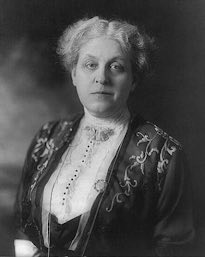Growing up on the Iowa frontier, young Carrie Lane was active and self-reliant. She worked to put herself through Iowa State College, and become a principal and school superintendent, which were unusual posts for a woman.
When she married Leo Chapman, she joined him to co-edit a newspaper, but their marriage was cut short by his sudden death. As a young widow, she took to the lecture platform and began to work for woman suffrage, first in Iowa and then nationally.
Her second husband, George Catt, agreed she should devote two months each spring and fall to suffrage. She became a dynamic speaker, and exhibited a great talent for organization. Under her leadership, the days of isolated efforts and lost causes would end. More than any other woman except Susan B. Anthony, Carrie Chapman Catt was responsible for securing women’s right to vote.
In 1915, on the heels of a remarkable effort in New York State, Catt became the head of the National American Woman Suffrage Association and put into effect a secret “winning plan”. She led a push for an amendment to the federal constitution and at the same time continued campaigns in the states to increase the pressure and the numbers of suffrage states. A series of state victories followed in 1917 and 1918. They were only the prelude to a tough national ratification battle until Tennessee finally put the Nineteenth Amendment “over the top” in August 1920.
Carrie Chapman Catt also did international work for woman suffrage, repeatedly touring Europe and presiding in international suffrage groups.

